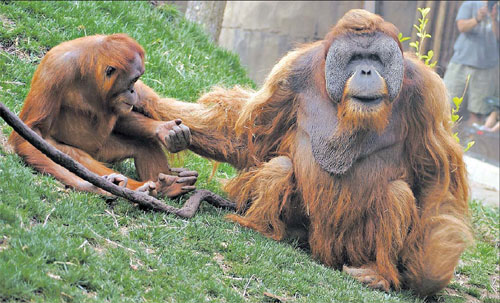Zoos ask: Now what?
 |
|
Controlling breeding at zoos presents few options. Orangutans at the Saint Louis Zoo get birth control. In Europe, euthansia is more prevalent. Carol Weerts / Saint Louis Zoo |
The choices are difficult when babies don't fit plan
Zookeepers around the world, facing limited capacity and pressure to maintain diverse and vibrant collections of endangered species, are often choosing between two controversial population limits: birth control and euthanasia.
In the United States, the choice is contraception. Chimps take human birth control pills, giraffes are served hormones in their feed, and grizzly bears have slow-releasing hormones implanted in their forelegs. Even small rodents are included.
Cheryl Asa, who directs the Association of Zoos and Aquariums' Wildlife Contraception Center at the Saint Louis Zoo, said euthanasia was not a comfortable fit. "On an emotional level, I can't imagine doing it and I can't imagine our culture accepting it," she said.
Dr. Asa sees contraception as a better approach. "By preventing the birth of animals beyond carrying capacity," she said, "more animals can be well cared for."
But in Europe, some zookeepers would rather euthanize unneeded offspring after they mature than deny the animal parents the experience of procreating and nurturing their young.
"We have already taken away their predatory and antipredatory behaviors," said Bengt Holst, director of conservation for the Copenhagen Zoo. "If we take away their parenting behavior, they have not much left."
So he and many of his European counterparts generally allow animals to raise their young until an age at which they would naturally separate from parents. It is then that zoo officials euthanize offspring that do not figure in breeding plans.
This spring, the Copenhagen Zoo put down, by lethal injection, two leopard cubs, about 2 years old, whose genes were already overrepresented in the collective zoo population. Leopards are considered near threatened by the International Union for the Conservation of Nature. But as part of a breeding plan to maintain the genetic diversity of this species, the cubs' fate was determined before they were born.
The Copenhagen Zoo, Mr. Holst said, annually puts to death some 20 to 30 healthy exotic animals - gazelles, hippopotamuses, and on rare occasions even chimps.


















